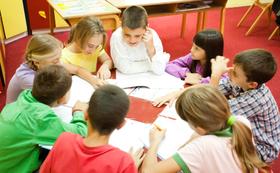Top Rankings
Greenfield School District ranks among the top 20% of public school district in Wisconsin for:
Category
Attribute
Graduation Rate
Highest graduation rate (Top 20%)
Diversity
Most diverse schools (Top 1%)
Community Size
Largest student body (number of students) (Top 1%)
For the 2025-26 school year, there are 4 public preschools serving 1,560 students in Greenfield School District. This district's average pre testing ranking is 3/10, which is in the bottom 50% of public pre schools in Wisconsin.
Public Preschools in Greenfield School District have an average math proficiency score of 37% (versus the Wisconsin public pre school average of 42%), and reading proficiency score of 38% (versus the 37% statewide average).
Minority enrollment is 54% of the student body (majority Hispanic), which is more than the Wisconsin public preschool average of 38% (majority Hispanic and Black).
Overview
This School District
This State (WI)
# Schools
6 Schools
1,031 Schools
# Students
3,410 Students
339,725 Students
# Teachers
264 Teachers
24,691 Teachers
Student-Teacher Ratio
13:1
13:1
Student By Grade
District Rank
Greenfield School District, which is ranked within the bottom 50% of all 443 school districts in Wisconsin (based off of combined math and reading proficiency testing data) for the 2022-2023 school year.
The school district's graduation rate of 94% has increased from 88% over five school years.
Overall District Rank
#345 out of 447 school districts
(Bottom 50%)
(Bottom 50%)
Math Test Scores (% Proficient)
30%
40%
Reading/Language Arts Test Scores (% Proficient)
33%
38%
Science Test Scores (% Proficient)
35%
44%
Graduation Rate
94%
90%
Students by Ethnicity:
Diversity Score
0.67
0.59
% American Indian
1%
1%
% Asian
8%
5%
% Hispanic
31%
15%
% Black
5%
12%
% White
48%
61%
% Hawaiian
n/a
n/a
% Two or more races
7%
6%
All Ethnic Groups
District Revenue and Spending
The revenue/student of $16,657 in this school district is less than the state median of $17,039. The school district revenue/student has stayed relatively flat over four school years.
The school district's spending/student of $15,436 is less than the state median of $17,011. The school district spending/student has stayed relatively flat over four school years.
Total Revenue
$57 MM
$13,869 MM
Spending
$53 MM
$13,846 MM
Revenue / Student
$16,657
$17,039
Spending / Student
$15,436
$17,011
Best Greenfield School District Public Preschools (2025-26)
School
(Math and Reading Proficiency)
(Math and Reading Proficiency)
Location
Quick Facts
Rank: #11.
Elm Dale Elementary School
(Math: 45-49% | Reading: 43%)
Rank:
Rank:
7/
Top 50%10
5300 S Honey Creek Dr
Milwaukee, WI 53221
(414) 281-7100
Milwaukee, WI 53221
(414) 281-7100
Gr: PK-5 | 465 students Student-teacher ratio: 13:1 Minority enrollment: 49%
Rank: #22.
Edgewood Elementary School
(Math: 50-54% | Reading: 35-39%)
Rank:
Rank:
7/
Top 50%10
4711 S 47th St
Milwaukee, WI 53220
(414) 281-5750
Milwaukee, WI 53220
(414) 281-5750
Gr: PK-5 | 321 students Student-teacher ratio: 14:1 Minority enrollment: 56%
Rank: #33.
Maple Grove Elementary School
(Math: 28% | Reading: 36%)
Rank:
Rank:
4/
Bottom 50%10
6921 W Coldspring Rd
Milwaukee, WI 53220
(414) 541-0600
Milwaukee, WI 53220
(414) 541-0600
Gr: PK-5 | 457 students Student-teacher ratio: 13:1 Minority enrollment: 55%
Rank: #44.
Glenwood Elementary School
(Math: 20-24% | Reading: 30-34%)
Rank:
Rank:
3/
Bottom 50%10
3550 S 51st St
Milwaukee, WI 53220
(414) 545-2280
Milwaukee, WI 53220
(414) 545-2280
Gr: PK-5 | 317 students Student-teacher ratio: 13:1 Minority enrollment: 54%
Recent Articles

Charter Schools vs Public Schools 2025: Key Differences & Trends
Explore updated 2025 insights comparing charter schools vs public schools, enrollment, academic outcomes, funding, and real-world examples for families and educators.

Are Public Schools Ready for the 21st Century? 2025 Update
Explore 2025 insights on whether public schools are ready for the 21st century, covering performance, technology, equity, funding, and future-ready learning.

Public School Open House & Enrollment Season Guide
A parent-focused guide to the public school open house and enrollment season, with expert questions, timelines, and decision tips.





